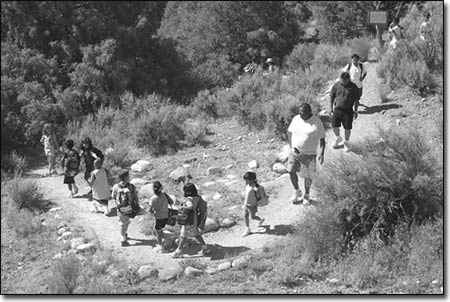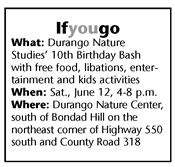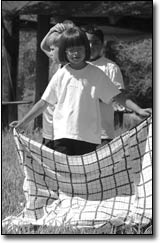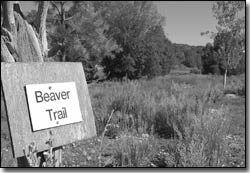|
Durango Nature Studies celebrates 10 years of environmental education
by Missy Votel
 |
| A group of children and their
chaperones from the Sun Ute Community Center start the short
hike down from the parking at the Durango Nature Center lot
to start the day's activities Tuesday morning. The children
are participating in a five-day summer day camp program at
the center, which is run by Durango Nature Studies./Photo
by Todd Newcomer. |
Metamorphosis may not be a word that rolls off the tongue of
typical 6- and 7-year-olds. So, in an effort to teach the simple
meaning to a big word, a volunteer naturalist with Durango Nature
Studies leads a group of Ignacio summer campers through a relay
race of the life cycle of a butterfly. After emerging from their
“eggs” (plastic garbage bags), the kids crawl into
their “cocoons” (old bed sheets) and then “flutter”
(flap their arms) as fast as they can back to the finish line.
 It’s
this type of hands-on approach that naturalists at the Durango
Nature Center rely on most in teaching kids and adults alike a
healthy respect and appreciation for the environment. It’s
this type of hands-on approach that naturalists at the Durango
Nature Center rely on most in teaching kids and adults alike a
healthy respect and appreciation for the environment.
“It’s all hands-on and interactive,” said Durango
Nature Studies Executive Director Lisa Branner. “It’s
really different from what kids deal with in the classroom on
a daily basis. It’s a way of teaching that really sticks.”
Apparently the approach is working. Like the story of the butterfly
that the students are emulating, DNS, celebrating its 10th year
June 12, has grown from a fledgling nature center operating in
a donated storage closet to a region-wide environmental education
organization serving more than 10,000 people a year.
“We have to turn requests away weekly because we are at
capacity,” said Leigh Gillette, Nature Studies program director.
The idea for Durango Nature Studies was hatched in 1992 by friends
and fellow naturalists, Ann Rilling and Janet Kenna, who saw a
need for an organization to educate the community on the natural
environment.
“At the time, it was something that Durango needed and
wanted,” said Rilling, who is still active in the organization
as project manager at the Nature Center. “There’s
really nothing else like it nearby. The closest one is in Albuquerque
or Pueblo.”
In 1993, the two joined forces with Caroline Johnson and Winston
Dines, and over coffee one morning, the ultimate goal took shape:
a nonprofit nature center that could double as a nature preserve.
By 1994, Durango Nature Studies opened for business, its first
audience a class of Japanese exchange students studying for the
summer at Fort Lewis College.
It also was at this time that a quest for a permanent site began
in earnest. In the meantime, as Branner recalled, all educational
hikes were held on various parcels of private land.
“We didn’t know what to expect – if the sprinklers
were going to be on or if the horses would be in the pasture,”
said Branner. “A lot of times we would have to improvise.”
Fortunately the search ended in 1998 when the organization bought
105 acres of piF1on and juniper south of Durango along the Florida
River for $130,000. Another adjoining 35 acres were bought in
2000 for $1 from a group of private supporters that purchased
the land earlier and placed it in a conservation easement.
“I never even really thought past the next day,”
said Rilling, reflecting on the organization’s success.
“You just keep going. It was being in the right place at
the right time.”
 |
Danika Evanson, 7, gets ready
for a relay race based on the life
cycle of a butterfly./Photo by
Todd Newcomer.
|
Ripples in a pond
The 140-acre Durango Nature Center boasts 3 miles of interpretive
trails, with signs describing the surrounding flora and fauna,
as well as prime riparian habitat, a live prairie dog colony,
an anthill and a children’s play area.
According to Branner, the Nature Center has taken the guesswork
out of the educational hikes, helping DNS customize its teachings
to the specific habitat, she said.
“I couldn’t imagine a more perfect site, it’s
working so well,” said Branner.
Durango Nature Studies’ flagship program is Children Discovering
Nature, a two-part series that serves more than 2,000 area schoolchildren
a year from Silverton to Farmington and Cortez to Pagosa Springs.
“If you know a kid in Durango, you know someone who’s
been through our program,” she said.
The program combines a classroom visit from a naturalist with
a half-day field trip to the Nature Center. The programs are tailored
to the age group and tied to state and local education standards
and what the children are currently studying in school.
According to Gillette, the outdoor segment of the program is
where most students excel.
“Kids are such natural learners and ready to soak it up,”
she said. “They do 90 percent of their learning by themselves.”
In addition to the Children Discovering Nature program, Durango
Nature Studies offers winter snowshoeing at Haviland Lake, which
includes animal tracking, plant identification and digging snow
pits, and summer camp programs, which cater to various groups.
Durango Nature Studies also has recently branched out into nearby
communities, conducting pilot children’s programs at a satellite
site in Pagosa Springs.
And while students make up the majority of 4 DurangoNature Studies’
clientele, the organization also offers several adult programs,
including its monthly full moon hikes at rotating locations.
 |
| A trail sign marks the beginning of over
three miles of paths crisscrossing the Durango Nature Center./Photo
by Todd Newcomer. |
“The best program right now is our Full Moon Hikes,”
said Gillette. “They’re about getting back to awareness
and what it’s like to walk out at dusk and into the night.
It’s about opening up the door and getting adults comfortable
in nature.”
According to Gillette, the adult programs run the gamut from
casual hikes to more specialized outings, including mushroom hunting
and medicinal herb identification.
“We have the basic awareness activities and then we have
the technical stuff for adults, so they can pick and choose,”
she said.
Another vital component of Durango Nature Studies’ is its
volunteer naturalist trainings. With only three paid employees,
the organization must rely on volunteers to lead the various programs.
To date, Durango Nature Studies has trained 250 volunteers who
offer up some 3,000 hours of service a year.
“We have a tremendous volunteer core, and we couldn’t
do it without them,” said Branner.
The trainings are held each spring and fall, and volunteers must
complete 17 hours of
instruction. Once that is done, they must commit to 35 hours
of service.
“It’s a pretty big commitment,” said Jennifer
Kleffner, Durango Nature Studies volunteer coordinator.
Kleffner said one volunteer has been with the group since 1996,
although not all volunteers return every year. Regardless, she
still sees the training as beneficial as a whole.
“It’s like ripples in a pond,” she said. “Even
if they don’t come back, they’ll still use what they
learn.”
Taking root
It is this ripple effect that Durango Nature Studies is relying
on as it heads into its next decade and continues to grow. According
to Branner, the biggest obstacles the organization faces are funding
and getting the word out about what Durango Nature Studies does.
She said she still hears comments from parents who have never
heard of Durango Nature Studies and don’t understand that
it relies on public support, grants, fund-raisers and memberships
to survive.
“The biggest thing is letting people know how this service
is made available and how it won’t be there without support,”
she said.
In addition, Branner said she also would like to see more pilot
programs in nearby communities as well as a bigger staff and more
programs exploring the varied ecosystems the area offers, from
alpine tundra to desert. The Durango Nature Studies Board of Directors
also is looking into the possibility of a permanent building at
the Nature Center site.
“We’re definitely experiencing growing pains, which
is good,” said Branner. “I think we’ll continue
to grow.”
And in Branner’s eyes, that’s a good thing.
“There are not that many places in the world that have
the kind of diversity Durango does, from mountains to desert.
A lot of people don’t realize that what we have here is
so special,” she said. “We try to help people focus
on that locally and get people to appreciate that so we can share
it with the next generation.”
|

